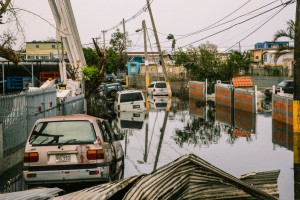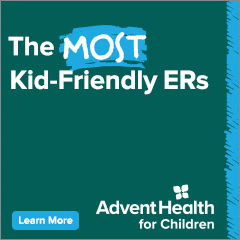With Open Arms
How Central Florida is extending its resources and more to Hurricane Maria’s evacuees—despite the state’s already stretched safety net system.
Hurricane Maria made landfall in Puerto Rico on Sept. 20, 2017, and since then, the implications of the storm can be felt in nearby Florida as thousands have sought refuge in the Sunshine State. While the migration numbers in Central Florida are difficult to gather, the office of Gov. Rick Scott recently stated, “Since Oct. 3, 2017, more than 199,000 individuals have arrived in Florida from Puerto Rico through Miami International Airport, Orlando International Airport and Port Everglades.” Additionally, it was said another 40,000 individuals were scheduled to arrive toward the end of 2017.
Yet, those numbers don’t just end there. Per a recent report by CUNY’s Center for Puerto Rican Studies, an estimated 114,000-213,000 Puerto Rico residents will leave the island annually as a result of Hurricane Maria’s aftermath. In response to those statistics, state and federal organizations have banded together to make sure these individuals are met with the resources they need to feel right at home in Central Florida.
Many locals are concerned with how this influx of individuals coming to Florida—some with short and long-term plans, while others are still figuring it out—could affect the state’s already stretched safety net system and its housing crisis. Orlando Family Magazine spoke with local officials and volunteers about what the state is up against and how they’re helping those individuals seeking refuge.
On the Front Lines
In unison with the country, Florida helped gathered supplies for the island ahead of Hurricane Maria, however, days following its landfall, it became clear to local officials that a wave of Puerto Rican residents would seek higher ground in Central Florida. Their response? They opened their arms.
Under the direction of Gov. Rick Scott, two Multi-Agency Resource Centers at Orlando International Airport (OIA) and Miami International Airport (MIA) were created for incoming families who were displaced by the hurricane. There, organizations—including Federal Emergency Management Agency (FEMA), the Department of Children and Families, the Department of Highway Safety and Motor Vehicles, the Department of Agriculture and Consumer Services, the Department of Health, the Department of Economic Opportunity, American Red Cross and Catholic Charities—set up shop to meet the needs of incoming individuals.
“We’ve had over 130,000 passengers since the outset of the storm, [and] we know we have another 40,000 scheduled to arrive,” explains Orange County Mayor Teresa Jacobs. “Making sure we had an assistance center set up, the state took the lead on that, but … we have other local agencies— state and federal agencies—that are necessary to assist evacuees to make that transition.”
Enter Heart of Florida United Way—which has been located at OIA since early October 2017, but as of press time, planned to transition to another facility to continue their work. “As [these individuals] arrived to the center, the operations that we had [at OIA] were to really assess the families, from the United Way perspective, as they’re arriving and [evaluate] their emotional and mental health because they’re coming facing trauma,” explains Operations Director Raquel McCormick.
Assessing a family consists of determining which individual needs medical attention—whether that’s medical, mental or spiritual—seeking case management or social security administration, meeting their most basic needs in terms of whether they require food or shelter, walking them through applying, capturing or transferring benefits, understanding where they’re at with FEMA and how to register children in the local educational system.
Additionally, United Way helped “bridge the gap” by helping those individuals find shelter in local hotels during the interim when FEMA’s Temporary Shelter Assistance (TSA) program— which has been made directly available to evacuees and offers hotels they can book themselves as opposed to working through the county and United Way—kicked off in mid-November. “We were able to close the two-day window while they got approved with TSA … making sure no one was left without a place to stay,” adds McCormick.
Medical Care
Local organizations from Shepherd’s Hope to Grace Medical Home have also stepped up to triage evacuees for emergencies, to help obtain medications and scripts or help navigate their benefits.
“The biggest thing we want to do is make sure they have the medications so they can see a doctor, get their scripts and get what they need,” explains Grace Medical Home CEO Stephanie Nelson Garris. “Navigating that is tricky because there’s questions surrounding what are they eligible for and how do they access it, so we’ve been working within the community to identify those resources as well.”
With an operation that serves people who are living at or below 200 percent of the federal poverty level and without insurance, Grace Medical works with a small clinical team and volunteers. At the outset of Maria, Garris explains her team began to recruit volunteer nurses, doctors, mental health and spiritual care counselors and administrators, in addition to launching a Friday clinic just for evacuees.
“We also have the Primary Care Access Network (PCAN), which is a collaborative of clinics who serve the underserved—whether it’s people on Medicaid or other free clinics—so we collaborate and try to get these patients into the best area,” adds Garris.
Yet, one of the most important services these clinics offer is mental health and spiritual counseling. “One of the things we’ve found is they’re just distraught and want to share their story,” she notes. “We’ve recruited bilingual volunteers [so] if they want to talk or if they want to have somebody to just sit with, [they can].”
While these organizations are banding together to help these individuals navigate their insurance or the lack thereof, one challenge many are unfortunately encountering are with their Medicaid benefits. As Jacobs explains, benefits available to U.S. citizens living in Puerto Rico dramatically differ from U.S. citizens living in Florida.
“We have a conference call coming up with FEMA and the Health Department [at a state level] … to make sure we don’t have people slipping through the cracks … and make sure that we can, as seamlessly as possible, ensure that people are getting medical care, their prescriptions, etc.,” she explains. “That in and of itself is a crucial, public health issue.”
The Education System
As of press time, a reported 1,300 students and more have enrolled in Osceola County schools. As of Dec. 18, 2017, a total of 3,492 students from hurricane-impacted areas have been enrolled in Orange County Public Schools—just 2,733 of that number is solely from Puerto Rico. Surprisingly, schools have been able to accommodate that number of new students thanks to their programs.
“We have a wide array of services and resources available to our students and families—especially in the schools where we’ve had the most growth—such as: guidance counselors, psychologists, SAFE coordinators, college and career counselors, peer-to-peer services, school mentors, Latino clubs and much more depending on the needs,” explains Shari Bobinski, senior manager, media promotions at Orange County Public Schools. “The staff in our schools understand that every child has their own story and their own unique needs and we work to help them with everything we can. We call that wraparound services and it’s something the district does for every child.”
As far as Spanish-only speaking students, the district has a large English Language Learners (ELL) population—meaning those who need to learn English—and has already implemented the necessary training amongst its teachers. “We have bilingual teachers, but we also have teachers who are getting better prepared to help children regardless of their home language to learn English,” adds Bobinski.
“In Orange County, we have students who come from nearly 200 countries and they speak about 170 different languages and dialects. It’s a very international community,” she explains. “Our teachers have to be equipped on how to help a child who doesn’t speak English make that transition into speaking English and there’s wonderful technology as well where a student can hold an iPad over a text in a text book and it converts it to their actual language.”
Additionally, acquiring incoming students’ records and transcripts hasn’t been an issue. “Nearly everything is online,” explains Bobinski. “Schools have been able to call school staff in Puerto Rico to get records. Also students are assessed when they start school to determine where they are at in the education.”
While the influx of enrollment hasn’t slowed down the district, there is, of course, always a concern—mostly when it comes to class sizes and having the additional funds and resources to provide quality education to both existing and new students. That is where Congresswoman Stephanie Murphy has stepped in by leading efforts in getting federal support to help these schools.
“The arrival of families from Puerto Rico also means that our school districts require additional resources,” Murphy said in a recent statement. “I’ve led a bipartisan effort to ensure that schools in Florida who enroll students from Puerto Rico have the support they need to provide a great education to both new and current students.
“I’m proud that, as a result of these efforts, the White House requested that Congress provide $1.235 billion for my initiative. I am now working to increase this funding level so that we can fully meet the needs of our schools and our students.”
A Housing Crisis?
The state’s housing shortage isn’t lost on Mayor Jacobs— as she explains that prior to Maria, it was one of their greatest concerns in making sure they had enough capacity in housing. Today, there’s a dramatic increase in the cost of rental units of apartments and as the mayor explains, while there was a glut of rental and owner-occupied housing during the recession, it has now been exhausted.
“We have more people demanding a place to stay than we have people building. … We have also embarked on an affordable housing tri-county initiative because it is becoming difficult for many in our local population to find housing until we can catch up with the demand and build the housing necessary,” she says.
“Fortunately, we’ve been able to accommodate the very large population we’ve had and at this point, there’s no plan for any sort of mass housing. We have looked at, early on, where would we have land that could accommodate that, how would our schools accommodate that, I’m not sure that’s the best solution as opposed to trying to make sure that as people make [the] decision if they’re leaving the island, that they have the information available to them to know if they’re looking at staying in a region that is at capacity.
“We’re probably close right now, but things are still functioning,” the mayor notes, adding, “We’ve been very relieved with the people who have come from the island and how many of them have made arrangements of their own. It has been nothing short of miraculous.”
Much to the mayor’s relief, housing these incoming individuals hasn’t been a crisis—thanks to the help of FEMA, Heart of Florida United Way and most importantly, the community. “Many people have opened up their homes to friends and family members from the island. It’s just been an outpouring of support and compassion, so we’ve been fortunate enough not to put too many people in hotels rooms.
“In my office, we’re always vigilant in recognizing that while things could be going well at some point, the ability to stay with families and double-up in houses may become strained and we may need to come up with a different approach,” she adds. “But at this point, we’re monitoring the situation.”
Looking Ahead
Aside from the housing situation, local, state and federal organizations continue to monitor Central Florida and assist incoming Puerto Rico residents. Yet, many volunteers and officials are concerned about future challenges.
“We’re all concerned because this was just an unexpected, unique thing,” says Garris. “But at the same time, we have a large Puerto Rican community here and I think we’ve all collectively tried to wrap our arms around them, welcome them and help navigate where they can go.”
In the educational arena, Bobinski worries about having enough teachers to keep up with the growing number of enrollments. “As we grow, we may have a tough time expanding the workforce when it comes to hiring enough teachers—especially in those hard-to-fill areas such as science and math,” she explains, adding, “And certainly teachers that speak more than one language are very helpful to us as well.”
With more individuals due to arrive, McCormick maintains Heart of Florida United Way will continue to support those families. “Our goal is to help them in the interim of all that is happening and there is a lot to come,” she says. “We do anticipate that second wave of folks,” this year.
Despite these concerns, each official and volunteer can all agree on one thing: They’re honored to help. “The reason why we did this,” notes Garris, “is we want to be a gap filler and serve people who don’t have any other place to go. … This was a privilege opportunity to serve people in need.”
This article originally appeared in Orlando Family Magazine’s February 2018 issue.









